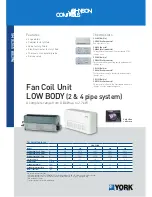
5
II. Read Before Proceeding
A. Local Codes
1. This unit shall be installed in accordance with those
installation regulations enforced in the area where
the installation is to be made. These regulations
shall be carefully followed in all cases. Authorities
having jurisdiction shall be consulted prior to
installation.
2.
This unit must be installed and serviced by a
licensed electrician or certified gas supplier.
3.
The City of New York requires a Licensed Master
Plumber to supervise the installation of this
product.
4.
The Commonwealth of Massachusetts requires
this product to be installed by a Licensed Plumber
or Gas Fitter.
B. Warranty
1.
This product has a limited warranty, a copy of which
is shipped with the unit. It is the responsibility of
the installing contractor to ensure all controls are
correctly installed and are operating properly.
2.
Factory warranty does not apply to units improperly
installed or improperly operated.
3.
Heat exchanger failure due to lime (scale) build-
up in the heat exchanger is not covered under the
manufacturer’s warranty.
4.
It is the responsibility of the customer to ensure
water hardness level and flow rate conform to the
levels listed in
C. Shipment Damage
1.
Upon receiving the unit, inspect for signs of
shipping damages. If the unit has been hit or
otherwise mishandled, immediately notify the
carrier.
2. Verify total number of factory supplied items as per
the packing slip with received parts.
D. Connecting Gas Supply Line
1.
Connect supply gas line to the ground joint union
inside the jacket of the appliance.
2. Failure to prevent the gas line from turning could
damage the gas train components on the appliance
(gas valve, blower, etc.).
E. Appliance Operation
1.
This appliance MUST NOT be installed in any
location where gasoline or flammable vapors are
likely to be present or, in an environment that
contains corrosive contaminants (see
).
2. Do not block or restrict in any way the flow of
combustion or ventilation air from or to the
appliance
3.
Do not use this appliance if any part has been under
water. Any appliance that has been under water
must be replaced. Water damage to the unit can
be extensive and present numerous safety hazards.
F. Gas Leakage (If you detect or smell gas...)
1. Do not try to light any appliance.
2.
Do not touch any electrical switch; do not use any
phone in the building.
3.
Immediately call your gas supplier from a neighbor’s
phone. Follow the gas supplier’s instruction.
4.
If you cannot reach your gas supplier, call the fire
department.
G. Maintenance
1.
To avoid electrical shock, ensure all electrical
connections are disconnected before attempting
installation or service of electrical components or
connections.
2. Lockout all electrical boxes with padlock once
power is turned off.
3. To prevent severe burns, allow the appliance to
cool before performing maintenance.
H. Product Identification Label
1.
A nameplate, in accordance with the ASME code
Section IV, is permanently attached to the heat
exchanger.
2. To access the nameplate, remove front jacket panel
from the appliance.






































